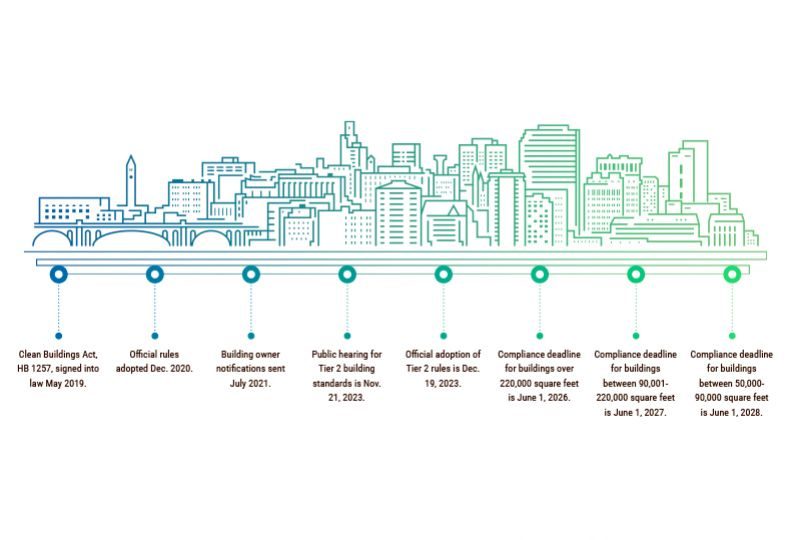
Home » Clean Buildings bill might get messy for commercial property owners
Clean Buildings bill might get messy for commercial property owners
Complying with new law could cost millions; some to make case for rollbacks

October 26, 2023
Some Spokane-area building owners will have to spend millions on building upgrades to comply with the energy-use and performance regulations outlined in the Washington state Clean Buildings Act, according to some downtown Spokane real estate advocates.
The rules are in place for larger buildings, but some organizations such as the Spokane Building Owners & Managers Association and Downtown Spokane Partnership are trying to rally support from owners of smaller buildings before the final rules are adopted for the smaller properties in December.
The Clean Buildings Act, which was passed in 2019, aims to reduce greenhouse gas emissions in Washington state by targeting buildings, which account for 27% of statewide emissions, according to the Washington state Department of Commerce.
The Washington Clean Buildings Performance Standards apply to Tier 1 buildings, which are commercial structures over 50,000 square feet in size, and they’ve been expanded to include Tier 2 buildings of 20,000 square feet or more, including multifamily buildings.
The performance standards state that building owners are required to reduce building emissions to a specific energy-use intensity target, report building performance, implement a maintenance-and-operations plan, report energy efficiency audits, and invest in measures to meet efficiency targets.
While the requirements for Tier 1 property compliance already have been established, a public hearing to set the rules for Tier 2 buildings has been scheduled for Nov. 21 with the Department of Commerce.
Clayton McFarland, commercial and leasing manager at Spokane-based Goodale & Barbieri Co., who also is president of BOMA Spokane, says the organization opposes the law because of the limited input from commercial building owners, ambiguous rules and regulations, and expensive fines.
Noncompliance can result in penalties for building owners of up to $5,000, plus continued violations of $1 per year per square foot.
“There are buildings that we know of where the upgrades to come into energy compliance are in the millions of dollars, but the fine would be in the tens of thousands or hundreds of thousands of dollars,” he says. “As a building owner, it might make sense to pay the fine and not make the energy upgrades at this time.”
Owners of buildings with 220,001 or more square feet of floor space will have until June 1, 2026, to meet the state’s deadline. For buildings with over 90,001 square feet up to 220,000 square feet, owners have until June 1, 2027; and for buildings greater than 50,000 square feet up to 90,000 square feet, property owners have until June 1, 2028.
The Clean Buildings Expansion Bill was passed in 2022. The expansion bill adds compliance requirements for Tier 2 buildings, which have 20,000 square feet or more and include properties such as grocery stores and smaller retail centers, says McFarland.
Rules for Tier 2 buildings must be finalized by the end of the year, and the deadline for compliance and reporting for those properties is July 1, 2027.
Both existing and new construction buildings will need to adhere to energy-use intensity targets that are 15% below 2009-2018 averages, according to the Washington state Department of Commerce’s website.
Andrew Rolwes, vice president of public policy at Downtown Spokane Partnership, says the DSP has asked Greater Spokane Incorporated to consider issuing a statement supporting regulation rollbacks. The statement suggests that the Legislature could delay implementation, expand exemptions, narrow rules to apply only to new buildings, or lower energy-use targets to realistic standards.
McFarland says commercial building owners generally want to lower utility costs and to have energy-efficient properties, but, “If the purpose of this bill was to make buildings more energy efficient, then I think it’s not going to achieve that. … A significant number of building (owners) might just pay a fine instead.”
The Clean Building Act does allow some exemptions for Tier 1 buildings, depending on occupancy, that could provide relief for some building owners. Exemptions are allowed if the primary use of the building is manufacturing or other industrial purposes, agricultural structures, or financial hardship, according to the Washington state Legislature’s website.
Conditions of financial hardship include properties on a city’s or county’s annual tax lien sale list; buildings that have a court-appointed receiver in control due to financial distress; buildings owned by a financial institution through default by a borrower; buildings that were acquired by a deed in lieu of foreclosure within the previous 24 months; or if the building has a notice of default on a senior mortgage.
The law was passed four years ago, before pandemic-induced supply-chain issues, labor shortages, and increasing costs of materials took hold in the construction industry, but with those ongoing challenges, McFarland says there’s additional pressure on building owners to meet the new energy standards.
For example, he says one of the properties under G&B’s management had a one-year lead time for the delivery of new rooftop HVAC units, which can cost up to $300,000 per unit.
McFarland adds, “There’s a number of buildings here in downtown Spokane that are not going to be able to make the metric. They can do everything they want. They could replace windows, they could replace HVAC units, they could put in all new electrical lines and … they’d still fall short.”
Buildings with historic significance aren’t exempt from the new energy standards either, and McFarland asserts that some of the historic properties will be changed significantly to accommodate needed upgrades.
“You can’t take a 1910 building and shove brand new systems in it, and have it work efficiently,” he says. “It might decrease the amount of space that you have dedicated for tenants.”
Updating Tier 2 properties likely will increase rents for tenants, McFarland claims, which is another reason he says public engagement at the Department of Commerce’s Nov. 21 meeting is so important for owners to attend.
“We have done our best to be involved in the process of rulemaking, despite being opposed to the bill,” McFarland says.
While BOMA Spokane opposes the new energy standards, McFarland says the association is doing what it can to support building owners by helping draft and pass legislation to finance property upgrades, with the Commercial Property Assessed Clean Energy + Resiliency program, dubbed C-PACER.
C-PACER allows building owners to borrow money specifically to meet the energy standards for the Clean Buildings Act, says McFarland.
“Unlike a traditional loan, the loan doesn’t follow the building owner, it follows the building until its paid off,” he says. “Frankly, there’s a lot of buildings that are not going to be able to (meet compliance) despite the ability to take out a loan.”
In order to comprehend the obligation of property owners to meet the standards of the Clean Building Act, owners will need to pay consultants to provide a complete assessment, explains Rolwes.
McFarland concurs and says depending on the type of building, its size, and location, complex assessments could cost about $150,000.
Public awareness and participation in the rulemaking process is the only option left for property owners who want to express their concerns to the Department of Commerce, says Rolwes.
“We can’t just say nothing,” he says. “We’re running out of time.”
McFarland concurs and says that while the deadline for the submission of new public comments has passed, BOMA representatives will attend the upcoming meeting to speak on behalf of its 120 members to reiterate challenges and hopefully find some areas to compromise.
“Hospitals, retail centers, day cares, schools, state government buildings, city government buildings, all of those will have to be compliant,” says McFarland. “It’s probably one of the most impactful pieces of legislation, at least in my professional career, that impacts the commercial real estate industry.”
Latest News Real Estate & Construction Government
Related Articles
Related Products




![Brad head shot[1] web](https://www.spokanejournal.com/ext/resources/2025/03/10/thumb/Brad-Head-Shot[1]_web.jpg?1741642753)
